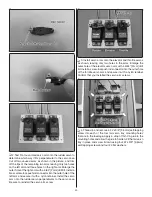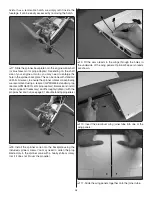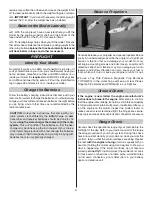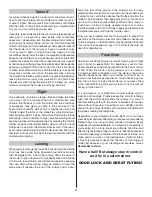
33
CHECK LIST
During the last few moments of preparation your mind may
be elsewhere anticipating the excitement of the fi rst fl ight.
Because of this, you may be more likely to overlook certain
checks and procedures that should be performed before the
model is fl own. To help avoid this, a check list is provided to
make sure these important areas are not overlooked. Many
are covered in the instruction manual, so where appropriate,
refer to the manual for complete instructions. Be sure to
check the items off as they are completed (that’s why it’s
called a
check list!
).
❏
1. Check the C.G. according to the measurements provided
in the manual.
❏
2. Be certain the battery and receiver are securely mounted
in the fuse. Simply stuffi ng them into place with foam rubber
is not suffi cient.
❏
3. Balance your model
laterally
as explained in the
instructions.
❏
4. Use thread locking compound to secure critical fasteners
such as the screws that hold the wheel collars to the axles,
engine mount screws, screw-lock pushrod connectors, etc.
❏
5. Add a drop of oil to the axles so the wheels will turn freely.
❏
6. Confi rm that all hinges are
securely
glued in place.
❏
7. Reinforce holes for wood screws with thin CA where
appropriate (servo mounting screws, etc.).
❏
8. Confi rm that all controls operate in the correct direction
and the throws are set up according to the manual.
❏
9. Make sure there are silicone retainers on all the clevises
and that all servo arms are secured to the servos with the
screws included with your radio.
❏
10. Secure connections between servo wires and servo
extensions using the included heat shrink tubing.
❏
11. Make sure any servo extension cords you may have used
do not interfere with other systems (servo arms, pushrods, etc.).
❏
12. Secure the pressure tap (if used) to the muffl er with
high temp RTV silicone, thread locking compound or J.B. Weld.
❏
13. Make sure the fuel lines are connected and are not
kinked.
❏
14. Balance your propeller (and spare propellers).
❏
15. Tighten the propeller nut and spinner.
❏
16. Place your name, address, AMA number and telephone
number on or inside your model.
❏
17. Cycle your receiver battery pack (if necessary) and
make sure it is fully charged.
❏
18. If you wish to photograph your model, do so before
your fi rst fl ight.
❏
19. Range check your radio when you get to the fl ying fi eld.
FLYING
Do not attempt to fl y by yourself if you are a beginning
pilot
. The Avistar’s docile fl ying characteristics makes learning
to fl y R/C an easier experience, but the help from an instructor
is invaluable. An instructor is going to be able to inspect your
airplane to make sure everything is working correctly and he
will also be able to give you a few tips and comments on how
to improve your fl ying. Also, make sure you fl y at an AMA
sanctioned fl ying fi eld.
CAUTION
(THIS APPLIES TO ALL R/C AIRPLANES): If,
while fl ying, you notice an alarming or unusual sound such
as a low-pitched “buzz,” this may indicate control surface
fl utter.
Flutter occurs when a control surface (such as an
aileron or elevator) or a fl ying surface (such as a wing or
stab) rapidly vibrates up and down (thus causing the noise).
In extreme cases, if not detected immediately, fl utter can
actually cause the control surface to detach or the fl ying
surface to fail, thus causing loss of control followed by an
impending crash. The best thing to do when fl utter is detected
is to slow the model
immediately
by reducing power, then
land as soon as safely possible. Identify which surface
fl uttered (so the problem may be resolved) by checking all
the servo grommets for deterioration or signs of vibration.
Make certain all pushrod linkages are secure and free of
play. If it fl uttered once, under similar circumstances it will
probably fl utter again unless the problem is fi xed. Some
things which can cause fl utter are; Excessive hinge gap;
Not mounting control horns solidly; Poor fi t of clevis pin in
horn; Side-play of wire pushrods caused by large bends;
Excessive free play in servo gears; Insecure servo mounting;
and one of the most prevalent causes of fl utter; Flying an
over-powered model at excessive speeds.
Taxiing
Before the model is ready for takeoff, it must fi rst be set up
to roll straight down the runway. With the engine running at
a low idle, place the plane on the runway and, if your fl ying
fi eld permits, stand behind the model. Advance the throttle
just enough to allow the model to roll. If the model does not
roll straight down the runway, shut the engine off and adjust
the nose gear pushrod as necessary. Do not use the rudder
trim to correct the nose wheel because this will also affect the
rudder.
Note
: Crosswinds may affect the direction the model
rolls, so this test should be done in calm conditions, or with
the model facing directly into the wind.




































